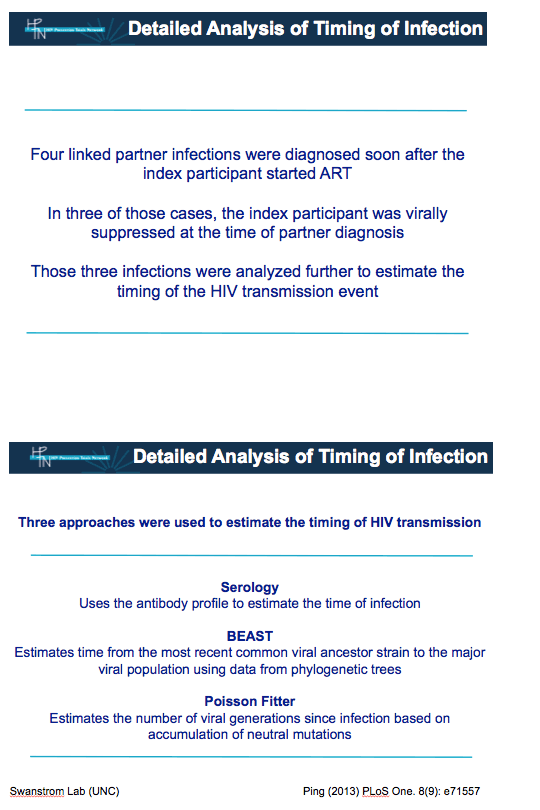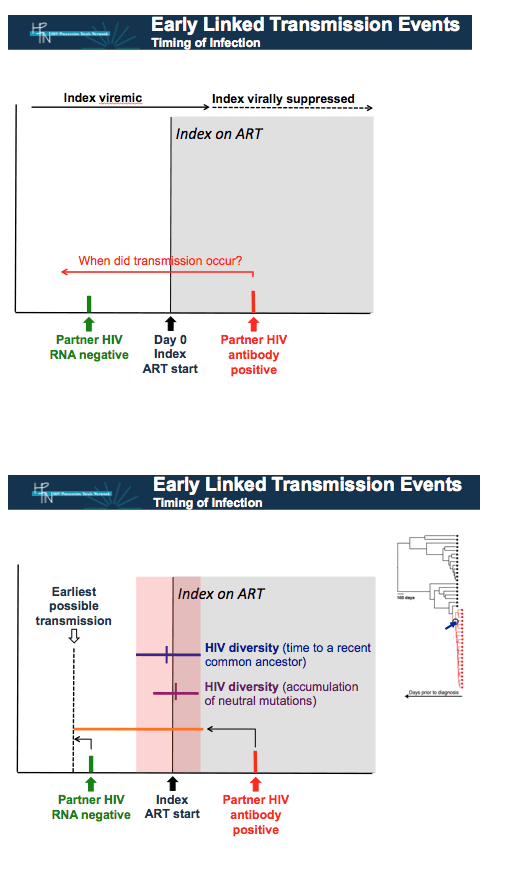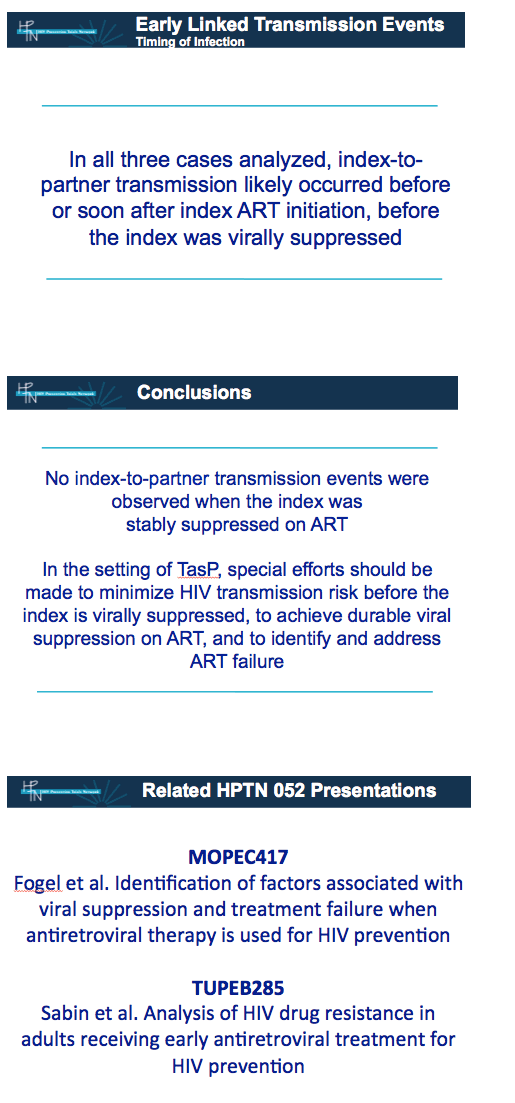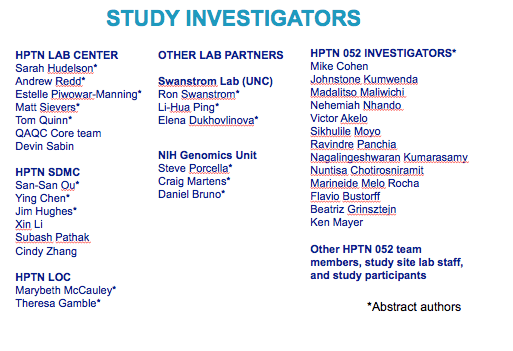 |
 |
 |
| |
Treatment as Prevention: Characterization of partner infections
in the HIV Prevention Trials Network 052 trial
|
| |
| |
Reported by Jules Levin
8th IAS Conference on HIV Pathogenesis, Treatment, and Prevention Vancouver, Canada, July 20, 2015
IAS: Antiretroviral Treatment Prevents HIV Transmission: Final Results from the HPTN 052 Randomized Controlled Trial - (07/22/15)
IAS 2015: 8th IAS Conference on HIV Pathogenesis Treatment and Prevention
Vancouver Canada18-22 July 2015
Susan Eshleman, MD/PhD
PI, HPTN Laboratory Center
Johns Hopkins Univ. School of Medicine
Baltimore, MD, USA







Identification of factors associated with viral suppression and treatment failure when antiretroviral therapy is used for HIV prevention: results from the HIV prevention trials network (HPTN) 052 trial
Presented by Jessica Fogel
J. Fogel1, S.S. Ou2, Y.Q. Chen2, E. Piwowar-Manning1, M. McCauley3, D. Sabin1, J. Eron4, J. Gallant5, T. Gamble6, M.C. Hosseinipour4,7, J. Kumwenda8, J. Makhema9, R. Panchia10, J.G. Hakim11, V. Akelo12,13, N. Mwelase14, S. Chariyalertsak15, S.V. Godbole16, N. Kumarasamy17, B. Grinsztejn18, J.H. Pilotto19, B. Santos20, K.H. Mayer21,22, M.S. Cohen4, S.H. Eshleman1, for the HPTN 052 Study Team
1Johns Hopkins Univ. School of Medicine, Dept. of Pathology, Baltimore, United States, 2Fred Hutchinson Cancer Research Center, Vaccine and Infectious Disease Division, Seattle, United States, 3FHI 360, Washington, DC, United States, 4Univ. of North Carolina School of Medicine, Dept. of Medicine, Chapel Hill, United States, 5Southwest CARE Center, Sante Fe, United States, 6FHI 360, Durham, United States, 7UNC Project, Lilongwe, Malawi, 8College of Medicine-Johns Hopkins Project, Blantyre, Malawi, 9Botswana Harvard AIDS Institute, Gaborone, Botswana, 10Univ. of the Witwatersrand, Perinatal HIV Research Unit, Johannesburg, South Africa, 11Univ. of Zimbabwe, Harare, Zimbabwe, 12Kenya Medical Research Institute, Kisumu, Kenya, 13Center for Disease Control, Kisumu, Kenya, 14Univ. of Witwatersrand, Clinical HIV Research Unit, Johannesburg, South Africa, 15Chiang Mai University, Research Institute for Health Sciences, Chiang Mai, Thailand, 16National AIDS Research Institute, Indian Council of Medical Research, Pune, India, 17Y. R. Gaitonade Center for AIDS Research and Education, VHS, Chennai, India, 18Instituto de Pesquisa Clinica Evandro Chagas, Fiocruz, Rio de Janeiro, Brazil, 19Hospital Geral de Nova Iguacu and Laboratorio de AIDS e Imunologia Molecular-IOC/Fiocruz, Rio de Janeiro, Brazil, 20Hospital Nossa Senhora da Conceicao, Porto Alegre RS, Brazil, 21Fenway Health, Boston, United States, 22Harvard Medical School, Boston, United States
Background: In HPTN 052, early antiretroviral therapy (ART) prevented 96% of linked HIV infections in serodiscordant couples. In this setting, HIV transmission can occur after ART initiation before viral suppression (VS) or after ART failure. We analyzed VS and ART failure in HPTN 052.
Methods: Data through May 2011 (trial unblinding) was analyzed for 1,036 participants who had a viral load (VL) >400 at ART initiation (early arm: N=832, CD4 350-550 at ART initiation, 1,647 person-years on ART; delayed arm: N=204, CD4 < 350 at ART initiation, 219 person-years on ART). VS was defined as the first of two consecutive VLs ²400. ART failure was defined as the first of two consecutive VLs >1,000 >24 weeks after ART initiation. Factors analyzed from the time of ART initiation included study arm, age, gender, CD4 count, VL, region (Americas/Asia/Africa), regimen (zidovudine/lamivudine/efavirenz vs. other), education level, marital status, and number of sex partners.
Results: Cumulative probabilities of VS at 1, 3, 6, and 12 months were 46.4%, 78.5%, 89.4%, and 92.9%. In a multivariate model, higher VL at ART initiation was associated with longer time to VS (hazard ratio [HR]: 0.87 [0.84, 0.91]; p< 0.0001). By May 2011, 93 participants in the early arm and 9 participants in the delayed arm failed ART. Time to ART failure and ART failure were analyzed for the early arm only. In univariate models, lack of VS by 3 months was associated with shorter time to ART failure (HR=9.34 [6.14-14.2]; p< 0.0001) and ART failure (odds ratio=8.99 [5.65-14.3], p< 0.0001). Findings were similar for lack of VS by 6 months. Weaker associations were observed for age and time to VS and for education level and failure outcomes.
Conclusions: Higher VL at ART initiation is associated with a longer time to VS, potentially increasing the risk of HIV transmission after ART initiation. A longer time to VS is associated with a shorter time to ART failure and ART failure, potentially increasing the risk of late transmission events. Further studies are needed to evaluate the relationships between VL, time to VS, ART failure, and HIV transmission when ART is used for HIV prevention.
Analysis of HIV drug resistance in adults receiving early antiretroviral treatment for HIV prevention: results from the HIV prevention trials network (HPTN) 052 trial
Presented by Devin Sabin
D. Sabin1, S.E. Hudelson1, S.S. Ou2, S. Hart3, C. Wallis4, M.G. Morgado5, S. Saravanan6, S. Tripathy7, E. Piwowar-Manning1, Y.Q. Chen2, M. McCauley8, L. Hovind3, J. Eron9, J. Gallant10, T. Gamble11, M.C. Hosseinipour9,12, J. Kumwenda13, J. Makhema14, R. Panchia15, J.G. Hakim16, V. Akelo17,18, S. Faesen19, S. Chariyalertsak20, S.V. Godbole21, N. Kumarasamy6, B. Grinsztejn22, J.H. Pilotto23, M. Melo24, K.H. Mayer25,26, M.S. Cohen9, S.H. Eshleman1, for the HPTN 052 Study Team
1Johns Hopkins Univ. School of Medicine, Dept. of Pathology, Baltimore, United States, 2Fred Hutchinson Cancer Research Center, Vaccine and Infectious Disease Division, Seattle, United States, 3Frontier Science & Technology Research Foundation, Amherst, United States, 4Lancet Laboratories, Johannesburg, South Africa, 5Oswaldo Cruz Institute, Laboratory of AIDS and Molecular Immunology, Rio de Janeiro, Brazil, 6Y. R. Gaitonade Center for AIDS Research and Education, VHS, Chennai, India, 7National JALMA Institute of Leprosy and Other Mycobacterial Diseases, Uttar Pradesh, India, 8FHI 360, Washington, DC, United States, 9Univ. of North Carolina School of Medicine, Dept. of Medicine, Chapel Hill, United States, 10Southwest CARE Center, Sante Fe, United States, 11FHI 360, Durham, United States, 12UNC Project, Lilongwe, Malawi, 13College of Medicine-Johns Hopkins Project, Blantyre, Malawi, 14Botswana Harvard AIDS Institute, Gaborone, Botswana, 15Univ. of Witwatersrand, Perinatal HIV Research Unit, Johannesburg, South Africa, 16Univ. of Zimbabwe, Harare, Zimbabwe, 17Kenya Medical Research Institute, Kisumu, Kenya, 18Center for Disease Control, Kisumu, Kenya, 19Univ. of Witwatersrand, Clinical HIV Research Unit, Johannesburg, South Africa, 20Chiang Mai University, Research Institute for Health Sciences, Chiang Mai, Thailand, 21National AIDS Research Institute, Indian Council of Medical Research, Pune, India, 22Instituto de Pesquisa Clinica Evandro Chagas, Fiocruz, Rio de Janeiro, Brazil, 23Hospital Geral de Nova Iguacu and Laboratorio de AIDS e Imunologia Molecular-IOC/Fiocruz, Rio de Janeiro, Brazil, 24Hospital Nossa Senhora da Conceicao, Porto Alegre RS, Brazil, 25Fenway Health, Boston, United States, 26Harvard Medical School, Boston, United States
Background: HPTN 052 demonstrated that early antiretroviral therapy (ART) prevented 96% of linked HIV infections in serodiscordant couples. Antiretroviral (ARV) drug resistance could potentially compromise the efficacy of ART for HIV prevention. Furthermore, factors associated with emergence of resistance may be different when ART is initiated at higher CD4 counts. We evaluated resistance in participants in the early ART arm of HPTN 052 who failed ART before May 2011 (trial unblinding).
Methods: Early ART arm participants reported no prior ART and initiated ART at CD4 counts of 350-550 cells/mm3; 72% received zidovudine/lamivudine/efavirenz (ZDV/3TC/EFV). ART failure was defined as two consecutive viral loads (VLs) >1,000 copies/mL >24 weeks after ART initiation. Resistance testing was performed using the ViroSeq system and Stanford algorithm version 6.3. HIV subtype was determined by phylogenetic analysis. Factors analyzed (data from the time of ART initiation) included age, gender, CD4 count, VL, region (Americas/Asia/Africa), regimen (ZDV/3TC/EFV vs. other), education level, marital status, number of sex partners, and time to viral suppression.
Results: By May 2011, 93 (10.7%) of 832 participants failed ART (1,647 person-years follow-up). Paired baseline/failure resistance results were obtained for 85 (89.5%) of those participants (42 from Africa; 29 from Asia; 14 from Americas; 69 subtype C, 16 other subtypes). Seven (8.2%) had baseline resistance: 1 had nucleoside/nucleotide reverse transcriptase inhibitor (NRTI) resistance; 3 had non-nucleoside reverse transcriptase inhibitor (NNRTI) resistance; 3 had NRTI+NNRTI resistance. Thirty (35.3%) had resistance at failure, including 27 (31.8%) with new resistance to ≥1 drug: 4 had new NRTI resistance; 4 had new NNRTI resistance; 19 had new NRTI+NNRTI resistance. Protease inhibitor resistance was not detected. None of the factors analyzed was associated with baseline resistance. Higher VL at ART initiation was associated with new resistance at failure (odds ratio=1.62 [1.16, 2.25], p=0.005).
Conclusions: HIV drug resistance frequently emerged in individuals who initiated ART at higher CD4 counts and failed treatment. This could potentially compromise the long-term efficacy of ART for prevention. Higher baseline VL was associated with resistance at ART failure. Further studies are planned to evaluate the relationship between baseline VL and resistance in early and delayed ART.

|
| |
|
 |
 |
|
|